Feature Article - Labour force participation in Australia
This article was published in the January 2005 issue of Australian Labour Market Statistics (cat. no. 6105.0).
INTRODUCTION
Most people in Australia participate in the labour force at some stage in their lives, with paid work the main source of income for many Australians. Participating in paid (or unpaid) work also provides opportunities for social interaction and job satisfaction. Participation in the labour force is therefore of interest from a social perspective.
There is also considerable interest in labour force participation from an economic perspective, particularly with respect to the ageing Australian population and the implications this may have for the size of the labour force. This is an issue for other countries as well, and the January 2004 issue of Australian Labour Market Statistics (cat. no. 6105.0) included an article ('Labour force participation: international comparison') comparing Australia's labour force participation experience with that of New Zealand, United Kingdom, United States of America and Canada.
A related issue is the age at which people retire (permanently withdraw from the labour force) and this is explored further in the article 'Experimental estimates of the average age at withdrawal from the labour force' in this issue (January 2005) of Australian Labour Market Statistics (cat. no. 6105.0).
Outline
This article examines the rate of labour force participation in Australia between 1983 and 2003. It looks at the differences between men's and women's participation over time, and considers other factors related to participation such as age and disability. It also assesses the role of part-time employment in the changing levels of participation.
The labour force participation rate is defined as the number of people in the labour force (i.e. either employed or unemployed) for any population group expressed as a percentage of the number of people in that population group.
CHANGES OVER TIME
Australia's labour force participation rate has increased slowly since 1983. In 1983 the participation rate was 60.4%; by 2003 it had risen to 63.6%. The main factor in the long-term rise in the labour force participation rate has been an increase in female participation, from 44.7% in 1983 to 55.9% in 2003. In contrast, male participation fell from 76.7% to 71.6% over the same period. Graph 1 shows male and female participation rates from 1983 to 2003, highlighting the convergence of the two over time. In 1983 the male participation rate was 32.1 percentage points higher than the female rate, however by 2003 the difference had been reduced to 15.7 percentage points.
Graph 1, Labour force participation rate(a)
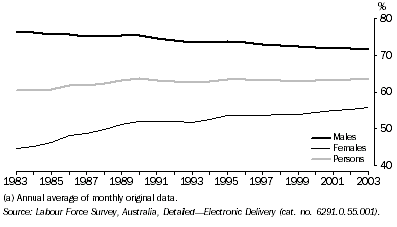
The economic cycle
The economic cycle has some influence on labour force participation. For example, the Australian participation rate fell 1.2 percentage points between 1990 and 1993, but by 1995 it was almost back to the 1990 level. This period spanned the 1990-91 economic downturn and subsequent recovery.
The participation rate for women varied more during this time than the participation rate for men. The article 'Unemployment and Participation Rates in Australia: A Cohort Analysis', in the July 2003 issue of Australian Labour Market Statistics (cat. no. 6105.0) examines the year effect for participation rates (as well as cohort and age effects), and discusses the influence of the business cycle on the labour market. It concludes that women's decisions to participate in the labour market appear to be more strongly influenced by the economic cycle than men's, possibly reflecting a propensity for women to exit the labour market rather than remaining unemployed when jobs become harder to find.
Changes in the labour market
Between 1983 and 2003, the nature of the labour market changed considerably. The proportion of employment that is part-time (end note 1) increased from 17% in 1983 to 29% in 2003. Women are more likely to work part-time than men (in 2003, 46% of employed women worked part-time compared to 15% of men), but the proportion of part-time work has increased for both women and men.
During the same period, there were considerable changes in the composition of employment by industry (end note 2). In 1985 (the earliest whole year for which ABS data are available for the current industry classification), 34% of all employed people were employed in goods-producing industries (end note 3), but this had dropped to 25% in 2003 (with the remaining 75% of employed people working in service industries) (end note 4). While most jobs in goods-producing industries are held by men (78% in both 1985 and 2003), the jobs in service industries are more evenly distributed between women and men (men held 53% of service industry jobs in 1985, decreasing to 48% in 2003).
The increase in part-time work may be related to the changes in the industry composition of the Australian economy, such as the growth of the services sector over the period. In 2003, 34% of people working in service industries were part-time workers, compared to 14% in goods-producing industries.
The changes in the labour market, with the increase in part-time jobs and jobs in service industries (jobs with a high proportion of women), have coincided with the large increase in the proportion of women in the labour force (end note 5). The changing industrial structure (described above) appears to be contributing to a rise in the importance attached to skills (end note 6), while jobs for low-skill workers are increasingly part-time and casual jobs (end note 7).
Table 2 shows participation rates for 1984 (the earliest year for which the educational attainment categories shown in this table are available) and 2003 according to educational attainment. For both men and women, participation was higher for those with non-school qualifications, with people with a degree or higher having higher levels of participation than people with any other level of qualification, in both 1984 and 2003. In 2003, 91.8% of men aged 15-64 years with a degree or higher were participating in the labour force, compared to 75.8% for men without non-school qualifications. The comparable particpation rates for women aged 15-64 years were 82.6% with a degree or higher and 59.1% without non-school qualifications.
Table 2, Labour force participation rate, By age and educational attainment - 1984 and 2003 |
|  |
 |  | 15-24 years
| 25-44 years
| 45-54 years
| 55-64 years
| Total (15-64 years)
|  |
 |  | 1984 | 2003 | 1984 | 2003 | 1984 | 2003 | 1984 | 2003 | 1984 | 2003 |  |
Males (%) |  |
|  |
| With non-school qualifications | 96.4 | 89.2 | 97.5 | 94.8 | 95.3 | 94.0 | 68.5 | 72.4 | 93.3 | 90.7 |  |
 | Degree or higher | 87.6 | 86.7 | 97.7 | 94.2 | 98.4 | 96.3 | 77.4 | 77.1 | 94.8 | 91.8 |  |
 | Advanced Diploma/Diploma/Certificate III/IV | 97.9 | 90.0 | 97.3 | 95.5 | 94.6 | 92.8 | 66.7 | 70.8 | 92.7 | 90.4 |  |
 | Other qualification | 98.9 | 90.0 | 100.0 | 93.5 | 98.5 | 93.3 | 65.0 | 67.9 | 96.9 | 88.8 |  |
| Without non-school qualifications | 74.5 | 66.0 | 94.7 | 87.4 | 89.5 | 84.4 | 60.4 | 59.9 | 82.0 | 75.8 |  |
| Total | 79.1 | 71.7 | 96.2 | 92.0 | 92.2 | 90.2 | 63.6 | 66.7 | 86.7 | 83.6 |  |
Females (%) |  |
|  |
| With non-school qualifications | 84.8 | 85.2 | 64.9 | 78.8 | 60.4 | 82.4 | 35.3 | 59.2 | 65.5 | 78.1 |  |
 | Degree or higher | 86.0 | 88.6 | 76.0 | 83.6 | 78.5 | 85.7 | 57.0 | 63.5 | 76.6 | 82.6 |  |
 | Advanced Diploma/Diploma/Certificate III/IV | 85.2 | 83.9 | 62.1 | 77.5 | 58.8 | 82.6 | 33.2 | 60.0 | 63.6 | 77.3 |  |
 | Other qualification | 74.6 | 82.9 | 60.4 | 70.9 | 47.6 | 76.2 | 23.6 | 53.2 | 56.6 | 71.3 |  |
| Without non-school qualifications | 62.9 | 62.9 | 48.9 | 63.7 | 44.1 | 66.7 | 17.5 | 34.7 | 47.0 | 59.1 |  |
| Total | 67.9 | 68.9 | 55.2 | 72.2 | 48.3 | 74.2 | 20.9 | 43.7 | 52.6 | 67.8 |  |
|  |
Between 1984 and 2003, the participation rate for women rose 12.6 percentage points for those with non-school qualifications, and 12.1 percentage points for those without any non-school qualifications. Thus, the increase in participation for women was not confined to women with higher skill levels.
In contrast, participation rates for men fell for all levels of educational attainment, but the fall was least for men with higher skill levels. The participation rate for men without non-school qualifications fell by 6.2 percentage points, while the rate for those with non-school qualifications fell by only 2.6 percentage points.
DIFFERENCES BY AGE AND SEX
Labour force participation varies considerably between age groups, reflecting life phases such as studying, child-raising (particularly for women), and retirement. This is illustrated below in Graph 3, which contrasts age-specific participation rates in 1983 with those in 2003.
Graph 3, Age-specific Labour Force Participation Rates(a)
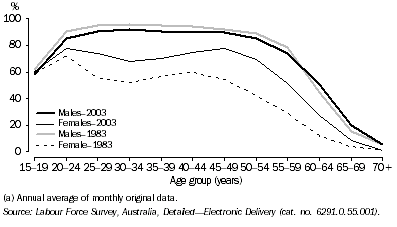
Women's participation has increased for almost all age groups, while men's participation has fallen slightly in most age groups. These changes are explored later in this article.
YOUTH AND PARTICIPATION IN EDUCATION
Participation rates for people aged 15-19 years and, to a lesser extent, for people aged 20-24 years are affected by participation in full-time education. While there has been little change in overall labour force participation rates for these age groups over the period 1983 to 2003, there have been changes in the proportion of full-time students, as well as the tendency of these students to participate in the labour force. In 1987 (the first whole year that data on full-time students aged 15-24 years are available from the Labour Force Survey), 32% of people aged 15-24 years were studying full-time and, of these, 35% were participating in the labour force. By 2003, there had been an increase in both the proportion of young people studying full-time (46%), and the proportion of full-time students who were in the labour force (50%).
WOMEN
Caring for children
The most common main activity of women aged 15-64 years who were not in the labour force was 'home duties/childcare', with 83% of women listing this as their main activity in 1983 and 56% in 2003 (as shown in Graph 4). The large decrease in the proportion of women with home duties as their main activity was common across all age groups.
Graph 4, Females not in the labour force(a), Main activity
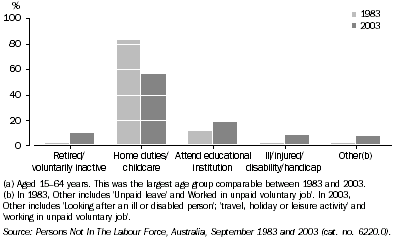
Graph 3 shows that participation rates for women were relatively high in the 20-24 year age group in both 1983 and 2003, and then declined for older age groups, when many women leave the labour force to care for children. However, the nature of this decline has changed. In 1983, the participation rate decreased from 72% for women aged 20-24 years to 55% for women aged 25-29 years. In 2003, the decline between ages 20-24 years and 25-29 years was relatively slight (from 77% to 74%) but there was a greater decline for women aged 30-34 years, who had a participation rate of 68%. This delay in the departure from the labour force reflects the increase in the median age of a mother at the birth of her child, from 26.9 years in 1983 to 30.5 years in 2003 (end note 8).
The decline in the female participation rate during child-caring years was smaller in 2003 than 1983, reflecting the fact that women with young children were more likely to be in the labour force in 2003. In 1983, the wife (or female partner) was in the labour force in 32% of couple families where the age of the youngest dependent child was less than 5 years (end note 9). By 2003 this proportion had increased to 52% (end note 10).
Caring for children impacts not just on the level of women's labour force participation, but also on the type of participation. Graph 5 shows a dip in full-time employment during the years women have children, accompanied by an increase in part-time work, highlighting the fact that many women combine part-time work with family responsibilities.
The increase in the age at which women are having babies is also reflected in Graph 5. While participation in full-time employment for women of child-bearing age was lowest for those aged 30-34 years in 1983, this effect was observed for women aged 35-39 years in 2003. The delay in having children is apparent in the part-time series as well. In 1983, the proportion of women in part-time employment was lowest (at 11%) for women aged 20-24 years, but then increased as more women combined part-time employment with caring for children. In 2003, the proportion of women involved in part-time employment was lowest for women aged 25-29 years (at 20%), increasing in each older age group up to age 40-44 years.
Graph 5, Employed persons as a percentage of population, Females
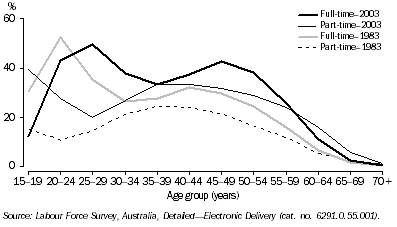
Post-childcare
Another change in the pattern of participation for women was an increased participation rate for women aged 40-49 years between 1983 and 2003 (see Graph 3), indicating that more women are now returning to the labour force after having children, and that they remain in the labour force for longer periods. In 1983, 60% of women aged 40-44 years were participating in the labour force, decreasing to 54% for women aged 45-49 years. In 2003, 75% of women aged 40-44 years were participating, and this increased to 78% for women aged 45-49 years.
MEN
Graph 3 shows that the decline in the male participation rate has occurred across almost all age groups (with the exception being men aged 60 years and older). Participation rates for men in the age groups from 25-29 years to 40-44 years were between 90% and 92% in 2003. While these rates are much higher than those for women, they are lower than those for men in 1983, when participation rates for the same age groups were around 94% to 96%.
This fall in the male participation rate may be linked to factors such as a declining number of jobs in goods-producing industries (which traditionally employ a high proportion of men), changing roles of men in families (with more 'stay at home dads'), and an increasing proportion of men receiving the disability support pension. The latter two factors are further considered in the following paragraphs.
Main activity when not in the labour force
Compared to women, whose most common main activity when not in the labour force was 'home duties/childcare', the main activity of men outside the labour force was more varied. In 1983, the most common main activities of males aged 15-64 years who were not in the labour force were 'attending an educational institution' (42%), 'retired/voluntarily inactive' (31%) and 'ill/injured/disabled/handicapped' (19%). By 2003 the proportion in the latter group had risen to 28%, while the proportions for the 'education' and 'retired' groups had fallen to 36% and 18% respectively. In Graph 6, the 'other' group also shows an increase from 1983 to 2003. In 2003 the two main activities in 'other' were 'travel, holiday or leisure activity' (4% of men not in the labour force stated this as their main activity) and 'looking after ill/disabled person' (3%).
Graph 6, Males not in the labour force(a), Main activity
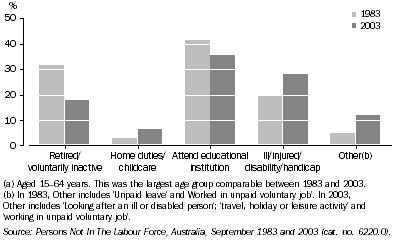
Caring for children
In 1983, 2.7% of males aged 15-64 years who weren't in the labour force said that their main activity was 'childcare/home duties'. By 2003, this had risen to 6.6%. Over the same period, the proportion of couple families where the husband was not in the labour force while the wife was in the labour force more than doubled, from 1.6% (end note 9) to 4.0% (end note 10). These statistics suggest that child-caring responsibilities may be one factor in the declining participation for men, but the proportion of men who did not have paid employment and had a female partner who worked was still relatively low.
Illness and disability
Illness, injury, handicap or disability may be a factor in the declining male participation rate. In 1983, 19% of men aged 15-64 years who were not in the labour force stated that their main activity was 'ill/injured/disabled/handicapped' (end note 11). By 2003 this figure had risen to 28%. Despite the overall increase, the 55-64 year age group was the only age group in which there was an increase in the proportion of men who reported this as their main activity. There was a slight decrease in all the other age groups (see Graph 7).
People with a disability are less likely to participate in the labour force than people without a disability. In 2003, 53% of those people aged 15-64 years who reported that they had a disability were participating in the labour force, compared to 81% of those who reported no disability (end note 12). The participation of people who report having a disability is decreasing, particularly for men. In 1993, 63% of men who reported a disability were participating in the labour force, compared to 59% in 2003. On the other hand, the labour force participation of men who reported no disability increased slightly (from 88% to 89%) in this period.
As shown in Graph 7, the proportion of men who were not in the labour force and reported their main activity as being 'ill/injured/disability/handicap' peaked in the 45-54 year age group (55% in 1983 and 53% in 2003) and then declined with age. This probably reflects the fact that later in life more men access an aged pension or superannuation rather than a disability pension and are hence more likely to report their main activity as 'retired/voluntarily inactive'.
Graph 7, Males not in the labour force, 'Ill/injured/disability/handicap'(a)
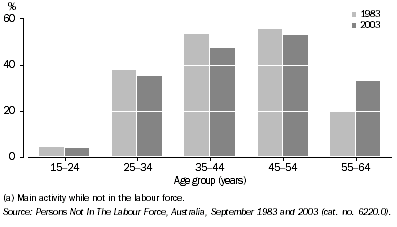
The rising proportion of men reporting 'ill/injured/disability/handicap' as their main activity coincides with the increasing number of men receiving the Disability Support Pension (DSP). In 1983, 3.0% of the male population aged 20 years and over received DSP. This figure had risen to 5.7% by 2003. The increase occurred across all age groups. Graph 8 shows that the proportion of men receiving DSP peaked for men aged 50-59 years in both 1983 and 2003 and then declined for men aged 60 years and over.
Graph 8, Proportion of males receiving DSP
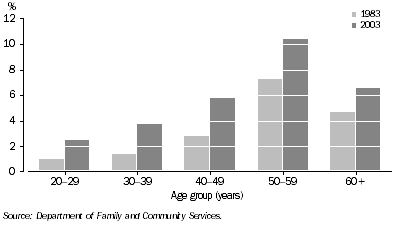
The increase in men reporting 'ill/injured/disability/handicap' as their main activity when not in the labour force and the increase in men receiving DSP may be caused by a number of factors related to either health or the labour market. Studies by researchers in Australia and other countries suggest that increases in the take up of disability insurance benefits may also be strongly influenced by the eligibility criteria for these benefits (end notes 13 and 14).
FURTHER INFORMATION
For further information about statistics on labour force participation in Australia, please contact the Assistant Director, Labour Supply on Canberra (02) 6252 6562.
For email enquiries please contact Client Services on client.services@abs.gov.au.
END NOTES
1. Part-time workers are defined as those who usually work less than 35 hours per week, and either did so during the reference week, or were not at work in the reference week. < Back
2. See the article 'Changes in labour force participation across generations' in the 2003 issue of Australian Social Trends (cat. no. 4102.0). < Back
3. In this article, goods-producing industries are defined as Construction; Agriculture, forestry and fishing; Manufacturing; Mining; and Electricity, gas and water. < Back
4. In this article, service industries are defined as Property and business services; Accommodation, cafes and restaurants; Cultural and recreational services; Personal and other services; Health and community services; Retail trade; Education; Wholesale trade; Government administration and defence; Finance and insurance; Transport and storage; and Communication services. < Back
5. See the article 'Changes in labour force participation across generations' in the 2003 issue of Australian Social Trends (cat. no. 4102.0), page 138. < Back
6. Wooden, M. (2000), The Changing Labour Market and its Impact on Work and Employment Relations, Melbourne Institute of Applied Economic and Social Research, University of Melbourne. < Back
7. Wooden, M. (2000), 'The Changing Skill Composition of Labour Demand', Australian Bulletin of Labour, Vol, 26 191-198. < Back
8. Australian Historical Population Statistics (cat. no. 3105.0.65.001). < Back
9. Labour Force Status and Other Characteristics of Families (cat. no. 6224.0). < Back 1 < Back 2
10. Labour Force Survey, Australia, Detailed - Electronic Delivery (cat. no. 6291.0.55.001). < Back 1 < Back 2
11. Persons Not In The Labour Force, Australia (cat. no. 6220.0). < Back
12. Disability, Ageing and Carers, 2003 (cat. no. 4430.0). < Back
13. 'Health, disability insurance and labour force participation' (working paper no. 218), Bank of England Quarterly Bulletin, Autumn 2004 <http://www.bankofengland.co.uk/workingpapers/wp218.pdf>. < Back
14. Cai, Lixin and Gregory, Robert G. (2004), 'Labour Market Conditions, Applications and Grants of Disability Support Pension (DSP) in Australia', Australian Journal of Labour Economics, Vol. 7, No.3, September 2004, pp 375-394 (forthcoming). < Back
 Print Page
Print Page
 Print All
Print All